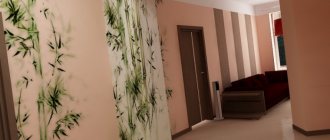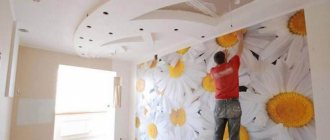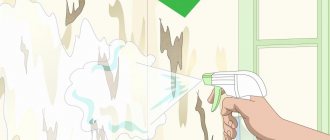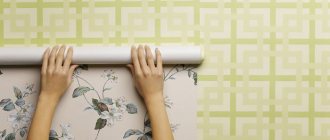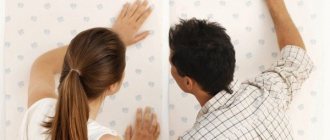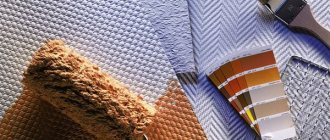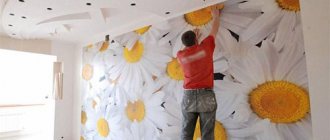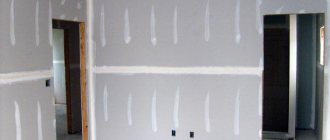Before you start decorating the walls, you must decide where to start wallpapering the room. Each room (be it a kitchen, a corridor, etc.) has its own characteristics, manifested in the presence/absence of niches, protrusions, corners, as well as in the nuances of lighting. In addition, you also need to take into account the type of wallpaper and the layout of the apartment.
Where to start gluing wallpaper in a room
Beautifully and evenly hung wallpaper always changes the interior and makes it more comfortable
Preparing for wallpapering
Tools for work
First, decide what the sequence of actions will be. And the first stage should always be preparatory work, which includes:
- purchase of everything necessary (wallpaper, adhesive, edging, primer);
- preparing the required tools (for work you will need a roller, knife, brushes, tape measure, scissors);
- covering the floor with protective material;
- preparation of communications and, of course, walls.
The preparation stage includes purchasing wallpaper, selecting tools, covering floors, cleaning walls.
Purchase materials in advance. Moreover, you need to think not only about how much glue and wallpaper will be needed, but also about the tools with which the composition will be applied. You can use PET film to cover the floor, although old newspapers will also work. It is recommended to turn off the electricity supply; it would be a good idea to remove sockets and lighting fixtures. It’s better to move the furniture out (alternatively, just move it to the center of the room and cover it with foil) to make the room as spacious as possible.
How to protect furniture and equipment from dust and dirt?
Walls that will be covered require especially careful preparation. The old coating must be removed, then the walls are puttied, leveled and primed. Also, before gluing, the room is well ventilated, after which the doors/windows are tightly closed to avoid drafts.
Walls and ceilings must first be cleaned of old coating
Preparing walls before wallpapering
Preparing for wallpapering
Priming the walls
What to do if the walls are completely crooked
Note! Also make sure that there is a special place on the floor where you will mark, cut and apply glue to the wallpaper. Below we will tell you how to glue different types of wallpaper in different rooms.
Work can also be done on a small table
Calculator for calculating the number of rolls of wallpaper for pasting a room
Go to calculations
Types of lathing
Let's move on to installation and start with choosing the sheathing. The sheathing is made from:
- wooden beams;
- profiles for fastening drywall;
- metal U-shaped profiles for siding;
- plastic structures designed for the installation of vinyl and acrylic panels.
Before installing the sheathing, inspect the surface. If there are cracks, crevices and other defects on it, they need to be repaired. If the old cladding is crumbling (for example, paint or plaster), it must be removed. If there are strong differences and unevenness on the walls, they should be smoothed out. Otherwise, the geometry of the wall will be disrupted and the siding may crack or deform.
After eliminating the unevenness, you need to treat the walls with a protective coating. To protect the walls of a wooden house, use an antiseptic and a fire retardant: the first will cope with moisture and rot, the second will prevent fire. Treat concrete walls with a deep penetration primer. It will prevent the appearance of mold and mildew.
Wooden sheathing for siding (photo No. 5)
The sheathing is mounted perpendicular to the siding panels. In other words, if you want to lay the siding horizontally, then the sheathing frame must be made vertical. And vice versa. The step between wooden beams or metal profiles should be 30-50 cm.
Hydro-wind insulation is laid under the sheathing. It protects the building from wind and moisture. Thanks to the presence of the lathing, a ventilation gap is formed between the walls of the house and the finishing panels. The gap prevents the appearance of condensation harmful to the walls and cladding. To keep the house warm, you can lay insulation between the sheathing. For this purpose, mineral wool and expanded polystyrene foam are used.
Let's take a closer look at each lathing option.
Wooden sheathing. It is made from beams 4 cm or 5 cm thick
When choosing beams, pay attention to the smoothness of the surface and the absence of cracks. Before installation, you need to dry the wood and cover it with solutions that protect the wood from rot and fire.
If you are faced with the question of how to attach siding to wood, then there are 2 options: with a screwdriver and self-tapping screws or with a hammer and nails.
Metal sheathing of walls and plinth (photo No. 6)
Profile for fastening drywall. If the goal is to save money, then profiles for interior work are used to install siding. Most often, sheets of plasterboard are attached to such structures. Manufacturers do not recommend using drywall profiles outdoors. Due to the thin zinc coating, corrosion occurs on them when exposed to moisture. They are intended for indoor use and are not suitable for attaching siding.
Metal U-shaped profile. To attach the siding, a durable metal profile 1 mm thick is also used. This design is more reliable than lathing with a plasterboard profile, but will be more expensive. If you use heavy cladding panels (for example, basement or metal siding), then you need to use street profiles.
Alta-Profile polymer façade fastening system. Polymer profiles are not subject to rust and rotting; they do not require additional processing or special storage conditions. If you choose vinyl siding to clad your building, you need to take into account that it expands in the hot summer and contracts in winter. Polymer profiles prevent deformation of cladding panels due to sudden temperature changes; they have the same coefficient of expansion as siding.
Plastic profiles are not subject to rust and rot (photo No. 7)
Where to start wallpapering the ceiling?
If the entire room, and the ceiling in particular, will be covered, then you should start there. There are 2 gluing methods that can be used for the ceiling:
- from the wall;
- from the center.
Finishing the ceiling has two methods of gluing wallpaper: from the wall and from the center.
In the first case, the work will be easier and faster, but the method is applicable only for wallpaper without a pattern (which is what is used in most cases for finishing ceilings).
But if there are patterns on the wallpaper, it is better to start gluing from the center in different directions - thanks to this, you will use the same number of solid strips. In this case, the design will also be symmetrical, which means it will be visually perceived correctly (the width of the stripes along the edges will be the same, which will ensure a harmonious and attractive appearance).
Ceiling pasting
When gluing, mark the entire ceiling from the center. To determine the central point, the entire area is divided into diagonals using a thread. The point where the threads intersect will be the center of the ceiling. Measure a distance from it that is equal to 1⁄2 the width of the roll (this is usually 53 cm: 2 = 26.5 cm). You need to lay the first strip between the markings, and the rest of the pattern will go from it.
On a note! If gluing is done from the wall, first draw a strip 50 cm wide (it is important that it is strictly perpendicular to the window). The first sheet is glued to this mark, and excess material near the wall is cut off using a construction knife.
Applying markings to a strip of wallpaper
From the door
Currently, builders, as a rule, strictly monitor the verticality of doors and corners. Unpleasant exceptions do occur, although they are rare. It is convenient to glue wallpaper from the door for the following reasons:
- the first and last strips do not have to be joined together;
- in areas such as a hallway or hallway, the doorway is often the only suitable landmark.
- if there is an unevenness somewhere, the door will cover it. This option is optimal when the pattern on the stripes must converge exactly.
It should be noted that even a very smooth-looking doorway will not hurt to check it once again with a good building level or plumb line.
Where to start wallpapering the walls?
In this case there are also several possible ways. The choice of one or another of them depends on the specific situation, while the type of wallpaper used must be taken into account. Almost all modern wallpaper needs to be glued end-to-end using one of the following methods:
- from the corner;
- from the door;
- from the window;
- from the center of the wall.
There are several options for wallpapering walls: from the middle of the wall, window, door, corner.
First, you need to make marks perpendicular to the floor surface, using a plumb line or level. Wallpaper can also be glued diagonally - in this case, a thread is stretched from the bottom corner to the diagonally opposite one, and a line is drawn along it. Wallpaper strips are glued obliquely, moving along the drawn line. It is better not to use this method for beginners - it is designed more for experienced craftsmen.
DIY wallpaper sticker on the wall
When using wallpaper with a pattern, difficulties may arise in any variant of perpendicular gluing. The most inconspicuous place is selected (for example, above the door) and gluing begins from there if there are difficulties in joining the patterns.
Gluing wallpaper from a window is quite simple. The height of the room is measured, another 10 cm of margin (for allowances) is added to the resulting figure, then the canvases are cut to match the pattern. The first strip is glued in accordance with the perpendicular guideline, and the rest - sequentially (in most cases - counterclockwise).
The method of finishing wallpaper from a window involves gluing counterclockwise
A few more important points
It is better to glue combined type wallpaper from the middle of the wall, the same applies to wall panels, when creating which you need to maintain a clear symmetry of the picture.
It is recommended to glue combined wallpaper from the middle of the wall
Chic wallpaper pattern
Note! You need to remove the covers from the sockets in advance, and then glue the wallpaper on top. The holes for them are cut out after the glue has dried. It is also better to trim off the excess after the glue has dried.
When gluing wallpaper from the corner, you should consider a few more important points. So, the corners are almost never perfectly straight. To check the evenness, use a building level or plumb line. You can draw a straight line perpendicular in the corner, and then start pasting from there.
In addition, you should not glue a whole strip in a corner, because when the glue dries, folds or distortions may appear on the material, which will cause the pattern to mismatch in the future. To correctly design a corner, follow the recommendations below.
- Choose the most inconspicuous corner and start gluing from there.
- Coat the corners thoroughly, as this is where the wallpaper comes off most often.
- Also treat the corners with a fungicide, because mold “loves” to grow in them.
It should be noted that there is no single algorithm for decorating walls with wallpaper in different rooms.
Tips and tricks from experts
It’s not difficult to hang wallpaper yourself if you carefully familiarize yourself with the work to be done and prepare the necessary materials. To save effort and time, experienced craftsmen have prepared several tips.
Wallpaper is glued for a long time, and there is no need to rush in this matter. If they are being remodeled, the old materials are removed, leaving bare walls. The material is moistened with water and scraped off with a spatula. When hot water does not cope, use a needle roller.
The clean wall is treated with antifungal agents and allowed to dry.
Remove the top layer from the painted wall using a drill with sandpaper or a chemical solution. Uneven places are leveled with putty (spotwise or entirely). The dried surface is treated with sandpaper and any remaining dust is removed.
Remove furniture from the room so that nothing restricts movement. The walls must be empty. Turn off the electricity, unscrew the sockets and switches. You need to stick wallpaper on the holes. When finished, carefully cut out the connectors and screw them back.
Pasting can begin from the corner. The fragment is placed a few centimeters from this zone. Starting work in a corner is only permissible using bright materials. They hide imperfections and visually expand the space. When finishing a door or window, it is recommended to first pay attention to the walls above and below the window, as well as above the doors. To glue the non-woven fabric, you need at least two people. Friends or relatives will help speed up the process and accurately carry out the planned repairs, since heavy rolls must be controlled along their entire length.
Gently brush or spatula over the surface, getting rid of air bubbles.
Do not cut the roll into equal parts. The measured area may differ from others. Add 1 more roll to the calculated amount of material (some fragments deteriorate during operation).
If the wallpaper is thin, it is recommended to overlap it in a left-to-right direction.
You can make a plumb line for measuring a flat vertical with your own hands; to do this, drive a nail near the wall or under the ceiling, onto which a meter-long rope is tied. A weight is tied to a rope above the floor. The wall is illuminated with a flashlight, and a straight line is drawn along the formed shadow.
Basic principles of wallpapering
Let's look at a few more basic principles, knowledge of which will greatly simplify your work.
Applying glue and pasting flat areas
The type of glue depends on the type of wallpaper used. To stir the diluted glue, it is better to use a special construction mixer so that the mixture is lump-free and homogeneous.
To apply the glue in an even layer, use a medium-width fluffy roller and a special paint bath. The glue is distributed on the strip of wallpaper (you need to move from the middle to the edges), then, when enough time has passed for impregnation (this is usually from 5 to 10 minutes), the strip is folded in half inward with the front side, without bending, and pressed against the ceiling. You need to focus on a vertical line made in advance.
After pressing the upper half, the lower half is released down and pressed in the same way. Bubbles are removed with a wallpaper spatula (you also need to move from the center to the edges), and if you use embossed wallpaper, you need to go over them with a rag. Excess material from above and below is cut off, and the knife should be as sharp as possible.
Wallpapering corners
The main stages of finishing an internal corner are discussed below, but they are also quite suitable for an external one.
Table No1. Instructions for wallpapering an inner corner.
| Steps, photo | Description of actions |
| Step 1 | According to the height of the wall and the pattern, prepare 2 strips (one whole and the other 10-15 cm wide). Apply glue to the stripes and wall. |
| Step 2 | A solid strip is applied to the wall in accordance with the pattern. Press the wallpaper firmly, then cut off the free edge. |
| Step 3 | It is advisable to glue a single strip with a slight overlap at the corner. After that, cut it along the contour of the corner (even if the corner is curved). |
| Step 4 | Then glue another strip, bringing it to the corner, press it well against the wall, but do not go to the edge that is on the adjacent wall with a wallpaper spatula. |
| Step 5 | Go over the joint with a narrow rubber spatula and remove excess glue. That's it, you have a finished, perfectly glued corner! |
How to glue vinyl wallpaper in corners
Video - Gluing wallpaper correctly
Wallpapering near doors, windows and behind radiators
In such hard-to-reach places you will have to try. But don't despair, we'll tell you how to deal with it.
Table No2. Instructions for wallpapering behind the radiator.
| Steps, photo | Description of actions |
| Step 1 | Measure a strip of wallpaper whose height is equal to the distance from the floor to the window sill. If it is impossible to remove the battery, make cuts in the places where it is attached and where the pipe connections are located. Apply glue to the strip and wait the required time. |
| Step 2 | Paste a strip of wallpaper behind the radiator. |
| Step 3 | Carefully insert it behind the radiator and press it firmly against the wall. Smooth the material with a rag, moving outward from the center. |
To hang wallpaper near doors/windows, do the following:
- prepare strips of the required length (from floor to window and from window to ceiling);
- apply glue;
- press the wallpaper to the wall, overlapping the slope/platband by a few centimeters;
- in the corner, make a cut at an angle of 45 degrees, cut off all excess, and push what is left behind the casing with a spatula;
- for the window, make a margin of a few centimeters around the slopes, then press the wallpaper well with a spatula. When the glue dries, carefully cut off any excess.
We glue wallpaper with our own hands near the doors
Making invisible joints
Gaps between strips are usually caused by too much glue. Because of this, the wallpaper becomes very wet, and its width increases by several millimeters. Then, when the glue dries, the wallpaper returns to its original size and, accordingly, a gap forms between the sheets. How to avoid this? Remove the facing layer from the unnecessary piece of wallpaper using sandpaper. Mix the resulting powder with PVA glue. You will end up with homemade grout that needs to be used to process the seams. Although, if you use plain wallpaper, you can also use paint.
Perfect joining of wallpaper sheets
Sometimes the seams are visible because there is glue on the front part. In this case, the problem can be solved with a special liquid for removing glue stains. If the liquid does not help, the wallpaper will have to be re-glued. Curled or loose edges of the wallpaper can be glued with a special glue for joints, and then re-rolled.
Where is the right place to start?
If the wallpaper is intended for overlapping wallpaper, you need to start from the corner near the window. This way the seams will not create shadows. And panels for end-to-end gluing can be started from any clearly visible place. It is most convenient to start from the corner by the window. This work is easier to do with two people.
- One person stands on a stepladder and marks a point with a pencil.
- A plumb line is applied to it, and the second person draws a line along the plumb line. At this mark they will begin to glue the wallpaper.
- Use a tape measure to measure the length of the wall.
- Roll out wallpaper on the floor and cut off the first strip, the size of which is 5-10 cm larger than the length of the wall.
With rapport selection
The most important point is the selection of the pattern.
Help All wallpapers have a constantly repeating pattern - rapport. We will combine it. It is best to do this on the floor.
- The remaining roll is applied end-to-end to the first strip so that the pattern continues (how to glue wallpaper end-to-end?). The excess is cut off (read how to properly trim the canvas in difficult places and choose a design here).
- This strip is superimposed on the previous one.
- Then they do the same. You need to measure out as many strips as will fit on one flat wall up to the corner.
Start gluing:
- Then one person on a stepladder applies the strip to the wall, starting from the top previously marked point.
- The second person below applies the wallpaper, aligning it with the marked line.
- The piece is glued starting from the center, leveling out to the edges. This is done with soft rags or a roller.
- The second strip is applied end-to-end to the first. The pattern is combined without leaning it against the wall, since glued wallpaper is very difficult to move.
- When everything is in contact exactly, they begin gluing, just like with the first segment.
Corner sticker technology
The room has internal and external corners. The inner corners are glued like this:
- The strip, selected according to the pattern, is laid out in two halves.
- The first is glued to the corner with an overlap of 1.5-2 cm. The second - the remainder is applied exactly to the corner.
The technology for gluing external corners is no different from the previous ones:
- it is also necessary to divide the strip into two parts - up to the corner with an approach of several centimeters;
- and exactly on the corner.
We invite you to watch a video that explains the intricacies of wallpapering in the corners:
With different print
Recently, wallpaper with different patterns has become increasingly used in interiors. This is done in order to place accents on certain parts of the room that they want to highlight. For example, a fireplace or a large TV, etc. Also for separating zones: in the nursery - a sleeping area and a study area, in studio apartments - a living area and a kitchen area, and many other options (more about zoning space with wallpaper is described in another material) .
Attention: To paste wallpaper from different zones, mark on the walls with a pencil the places where they will be connected. Determine how many stripes of the first and second colors are needed and stick them on. More complex is the horizontal combination of pasting:
More complex is the horizontal combination of pasting:
- Measure the distance from the floor to the joint.
- Then, at this height, draw a line parallel to the floor with a pencil.
- First, glue the top part of the wallpaper without gluing the bottom edge. He, in turn, goes beyond the mark by a couple of centimeters.
- Then the lower panels are glued and the upper edge, which is also located slightly above the outlined line, is not glued.
- When everything is dry, use a sharp knife to follow the mark, resting on a metal spatula. Excess paper strips are removed, and the unglued edges are glued end-to-end (how to join wallpaper?).
- If it doesn’t turn out very smooth, then the joint can be decorated using molding, plinth or paper border (you can read about how to glue wallpaper seam to joint and decorate the seams if it turns out not straight, here).
We invite you to watch a video about the technology of combining wallpaper:
Nuances of choosing wallpaper
In order to choose the appropriate type of wallpaper, consider several important points, including:
- room area;
- its purpose;
- humidity level;
- the condition of the ceiling/walls.
You can create a bright accent in the room by decorating one wall with wallpaper that will stand out in color.
Based on everything listed above, we can conclude that you can buy wallpaper of any type for dry rooms with smooth walls. Only after choosing the appropriate option can you decide where exactly to start gluing. If the room has high traffic and high humidity, then it is better to give preference to vinyl wallpaper.
In dry rooms with smooth walls, it is permissible to use any type of wallpaper
A good option for the living room is silk-screen printing, its shiny surface will give the room respectability
Paper wallpaper is a “lifeline” for inexpensive cosmetic repairs
Let's get acquainted with the characteristics of various types of wallpaper present on the modern market.
- Paper . They are characterized by the fact that they fit well on any surface (even the most difficult to reach) and can be combined with any other wallpaper.
- Fabric . This is the most expensive variety, ideal for a living room or bedroom. Able to hide minor damage on walls.
- Non-woven . They are very popular because of their density, relief, texture; They also mask imperfections well. External coatings vary greatly.
- Liquid . More reminiscent of decorative plaster, they can be used in any room. Read more about liquid wallpaper here.
- Vinyl . Very durable and dense, used for walls that are subject to serious dirt and stress.
Non-woven wallpaper has earned popularity due to its texture, reliefs with a dense structure
In rooms with high humidity and high traffic, it is better to use vinyl products
For the kitchen, the most suitable wallpaper options are vinyl or special canvases for painting.
Video - Gluing non-woven wallpaper
There is another variety - photo wallpaper, which allows you to create a unique interior and visually enlarge the space. When gluing them you must:
- use special glue for photo wallpaper;
- first lay out the fragments on the floor so that you end up with a complete picture;
- glue them onto perfectly flat surfaces.
Table No3. Instructions for gluing photo wallpaper.
| Steps, photo | Description of actions |
| Step 1 | Apply glue to the first sheet and to the wall. Fold the sheet in half so that the mixture is well absorbed for a few minutes. Then expand. |
| Step 2 | Smooth out the wallpaper using a rubber spatula. Treat the joints with a rubber roller. The fabric is absolutely not suitable for this! |
| Step 3 | Attach a second sheet, try to very carefully match the pattern (literally down to the millimeter). Smooth with a rubber spatula. Remember that many wallpapers provide trimming between the joints. |
| Step 4 | After gluing the wallpaper, cut the joint and remove the unnecessary strip. |
| Step 5 | Re-inspect the joints, try to ensure that they fit as closely as possible. Apply glue and roll over it. |
| Step 6 | Prepare a set of multi-colored pencils. Choose a color that matches the design and chop the lead with a blade. |
| Step 7 | Using the crushed stylus, carefully cover all scratches and joints with your finger. |
You can learn more about gluing photo wallpaper from the thematic video below.
Video – Proper gluing of photo wallpaper
What's better to put in a room?
In the process of choosing finishing materials for apartment renovation, first of all, you need to take into account that the quality of the coating largely depends on how suitable the selected materials are for use in a given room.
What types of wallpaper to choose for different rooms
For the bedroom
For example, to decorate walls in living rooms or bedrooms, it is better to use only “breathable” wallpaper. Other roll materials are not suitable for this purpose, because they do not allow air to pass through and do not absorb moisture, which can disrupt the microclimate in the room. Such wallpaper can be successfully used to decorate walls in the bathroom, hallway, toilet or kitchen.
For the hallway
In the hallway, the walls are best finished with moisture-resistant wallpaper with a friction-resistant outer layer. Typically, such wallpaper can be washed or repainted in any color.
Non-woven wallpaper with a pronounced pattern
For wallpapering in the bathroom, which differs from other rooms in high humidity, it is advisable to use moisture-resistant wallpaper. Paper-based wallpaper rolls are not suitable for the bathroom.
For kitchen
To decorate the walls in the kitchen and toilet, you can use any roll wallpaper, except linkrust. When renovating a bathroom or kitchen, some people prefer to separate functional areas. For example, near the sink or near the stove, it is advisable to use materials that can withstand repeated washing with detergents.
- One wall is highlighted with wallpaper with matching
- It is better to highlight a free wall with decor
- The apron in the kitchen should match the wallpaper on the walls
The walls near which the dining area will be can be covered with moisture-resistant wallpaper or even paper wallpaper.
Instead of traditionally painting the walls in the kitchen with oil paint, you can cover them with decorative self-adhesive film paper. To extend service life and strength, film paper is coated with varnish or latex.
For children's
When making renovations in children's rooms, it is better to give preference to wallpaper in greenish-yellow or pink shades
When choosing wallpaper for a room, you need to take into account the location of the windows.
Photo wallpaper is usually used for children's rooms.
If the windows in the apartment face north, the wallpaper should be chosen in warm colors: beige, orange, red or similar colors. They increase the illumination of the room, thereby reflecting sunlight. Wallpaper in cool colors: blue, green, brown-gray is used for rooms with windows facing south.
Most often, wallpaper or other finishing materials are made with a pattern, so when finishing work in an apartment, you need to take this into account.
For a small room
In small rooms, it is better to give preference to wallpaper with a small pattern; such wallpaper visually enlarges the room, while a large but not large-scale pattern on the wallpaper visually makes the room smaller.
Vertical lines on the walls, colors or patterns visually increase the height of the ceiling in the room, horizontal lines expand the visual perception of the walls. Following these recommendations, for rooms with low ceilings, choose a pattern located in the vertical direction, and leave the ceiling light.
For narrow rooms with a high ceiling, choose wallpaper with a horizontal pattern, and the ceiling is covered with non-woven wallpaper in a warm shade. This applies to a greater extent to wallpaper with stripes; with their help you can create an interesting decorative design for a room.
Option for wallpapering in rooms
For example, striped wallpaper can be glued to walls at an angle of 45° relative to the horizontal line. This design move looks especially impressive when the walls in the room are separated by shelves in the horizontal and vertical directions. Another option for gluing striped wallpaper is the herringbone pattern. In this case, the surface of the wall to be glued is divided into two symmetrical sections, where diagonally glued pieces of wallpaper are cut with a “double trim” and joined to each other along a vertical line dividing both sections.
Naturally, gluing wallpaper at an angle is very difficult, especially if you need to follow the pattern on the wallpaper. However, if you acquire some skills in interior decoration, you can achieve good results.
How to put wallpaper behind a battery without removing the battery
In addition to doors or windows, each room in the apartment has another difficult place to perform such work - central heating radiators. To increase the heat transfer of batteries, protective reflective panels are often installed behind them. Then you need to glue it around such a screen by analogy with windows or doors.
If there is no protective screen, you can remove the battery to glue wallpaper behind it. But few people will like this option, since additional difficulties arise with dismantling and installation, so everyone is interested in the answer to the question: how to hang wallpaper behind the radiator under the window without removing it.
Pasting in this place requires not only certain skills, but also the use of non-standard tools. One of them is a long, flat wooden ruler. The sequence of work at this stage will be as follows:
- A strip of wallpaper is passed behind the radiator, pushing it with a ruler all the way to the baseboard, then the unnecessary edge is folded or another mark of the required length is made.
- Carefully pull out the trellis and cut it according to the marks made. Lubricate the prepared strip with glue. Then they push it even more carefully behind the battery, straightening the canvas using the same wooden ruler.
If small defects appear behind the radiator in the form of wrinkles or air bubbles, do not be too upset. They won't be very noticeable. It is important to ensure that the pattern matches the visible part of the strip above the battery.
Eliminating shortcomings
It doesn’t matter where you start gluing wallpaper in a room, in the kitchen, hallway or children’s room, sometimes bubbles appear on it. These are usually air swellings - bubbles. They are very easy to remove with simple steps. To do this, glue is drawn into a regular medical syringe. The material is pierced with a needle and inserted into the swelling.
This can be done on both paper and non-woven wallpaper. The main thing here is to stick to the soaking time. If the paper ones take about 5 minutes, then the non-woven ones can be immediately glued to the base. Level with a roller or spatula to allow air and excess glue to escape.
Dried canvases may have peeling edges. You can glue them back either with the remaining glue using a brush, or with a special adhesive composition for seams. The second is applied pointwise, and for ease of use, it is produced in tubes.
